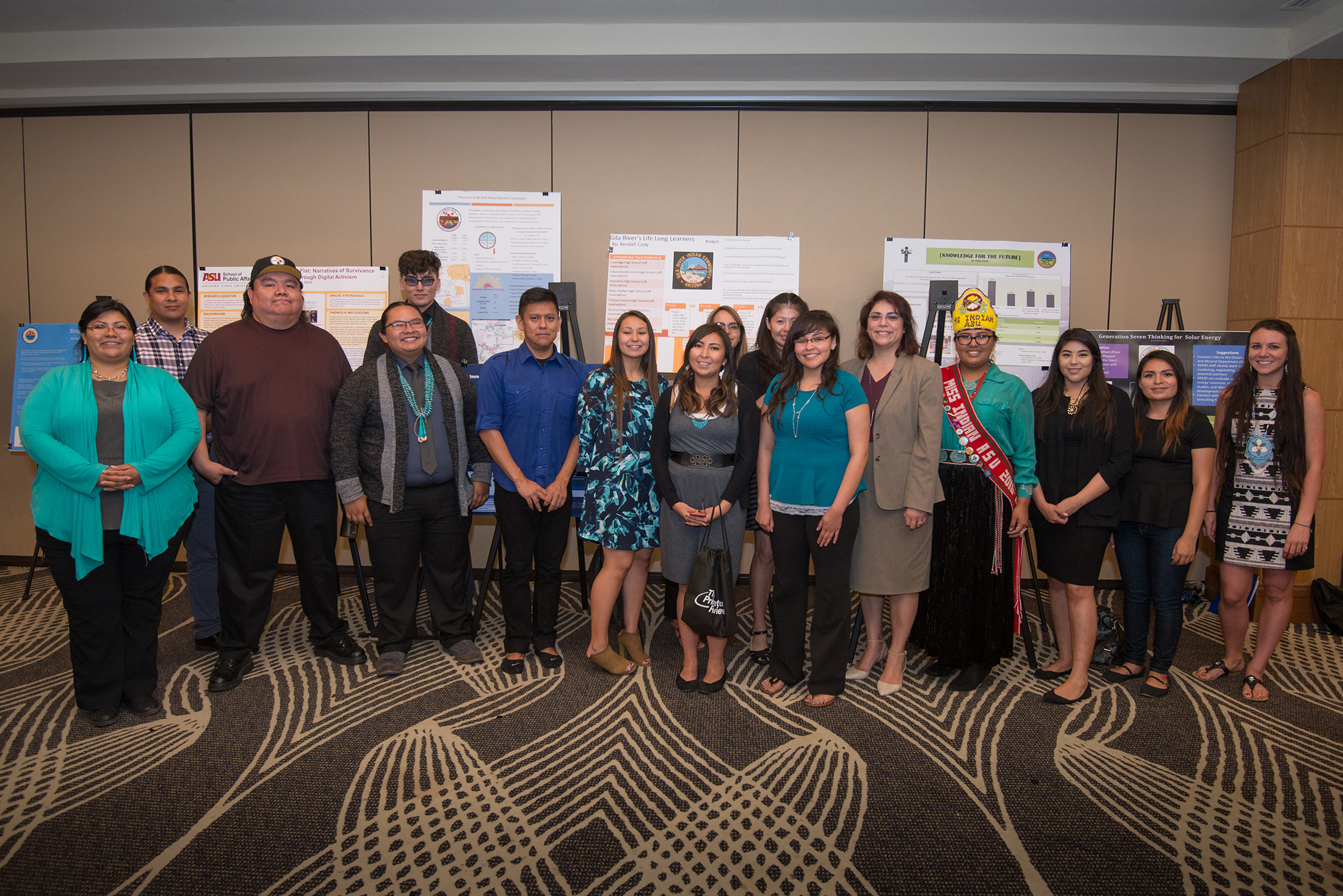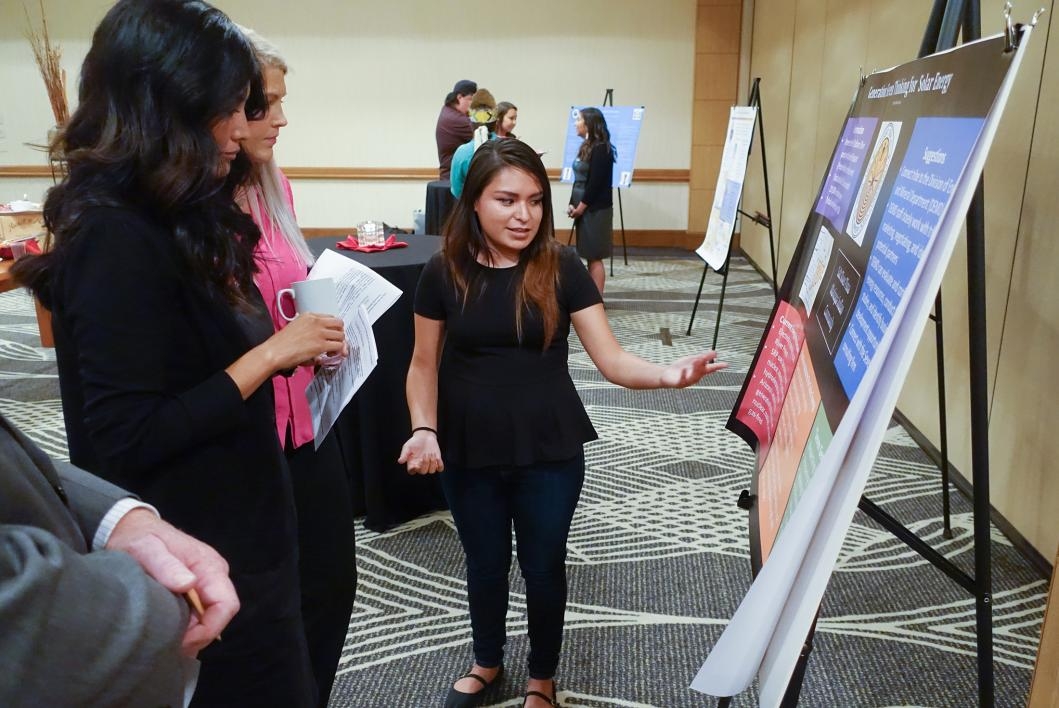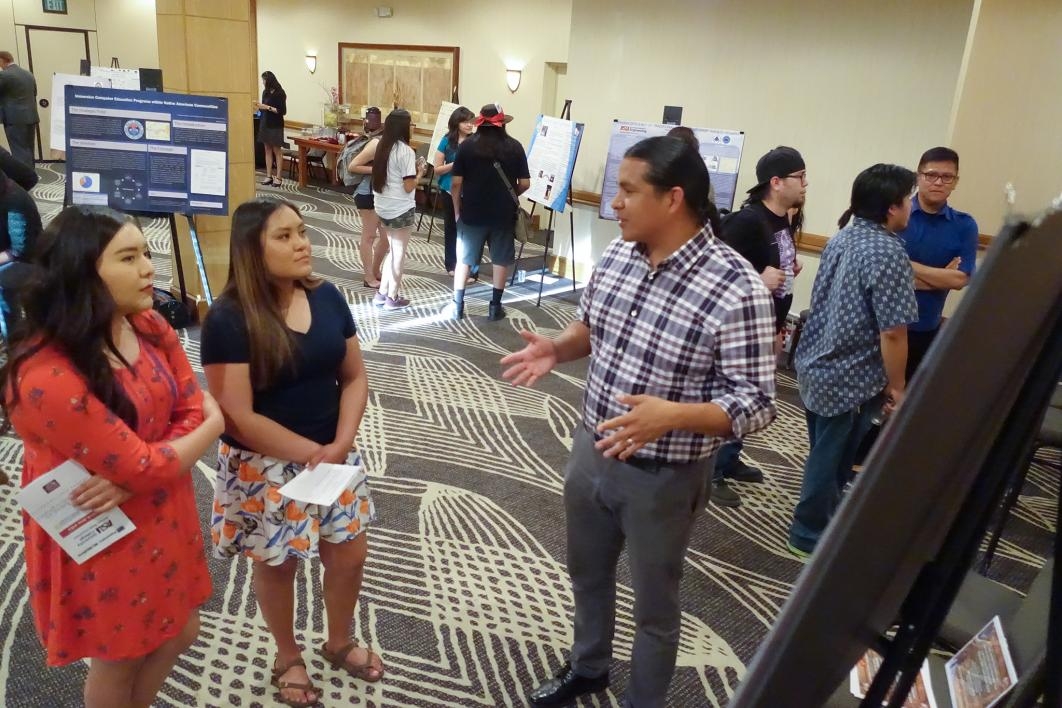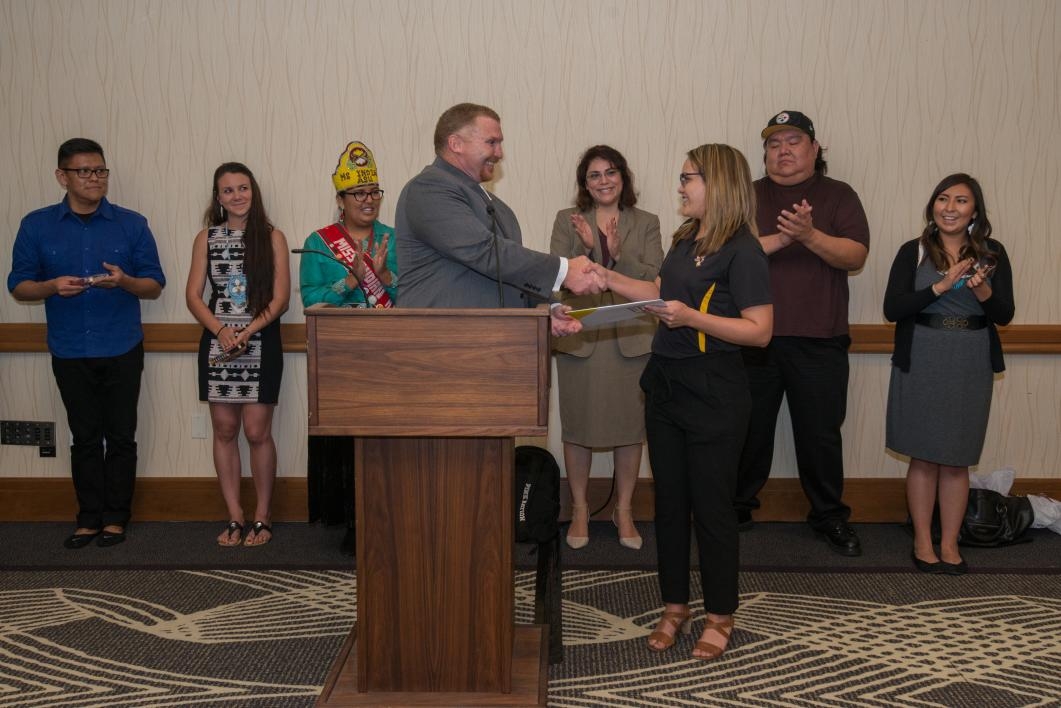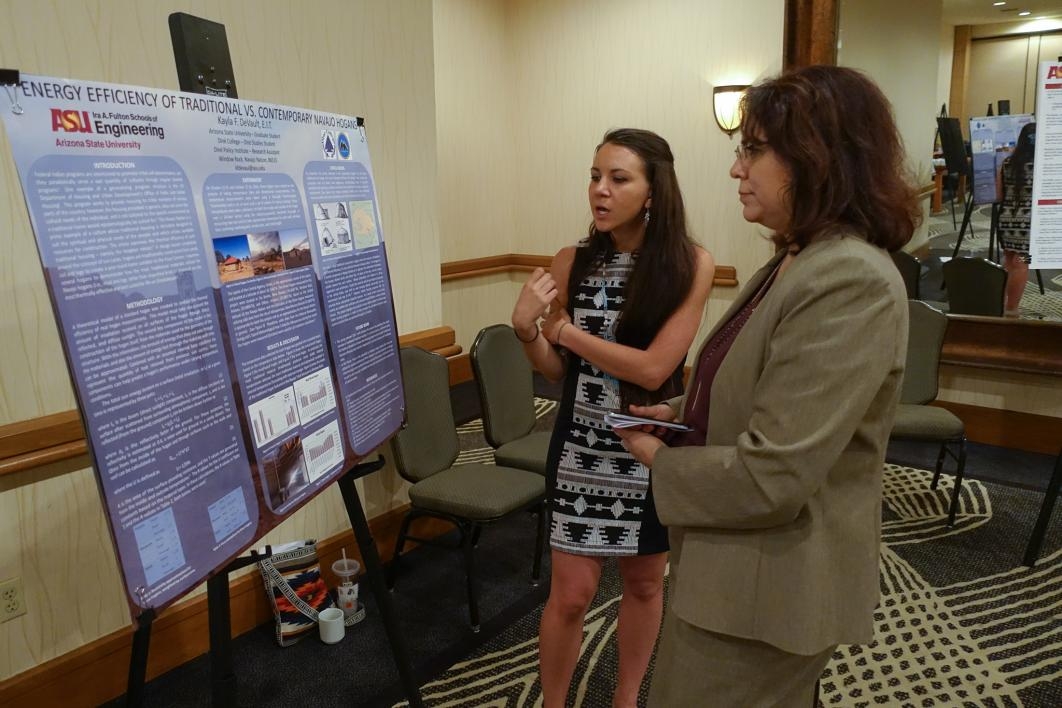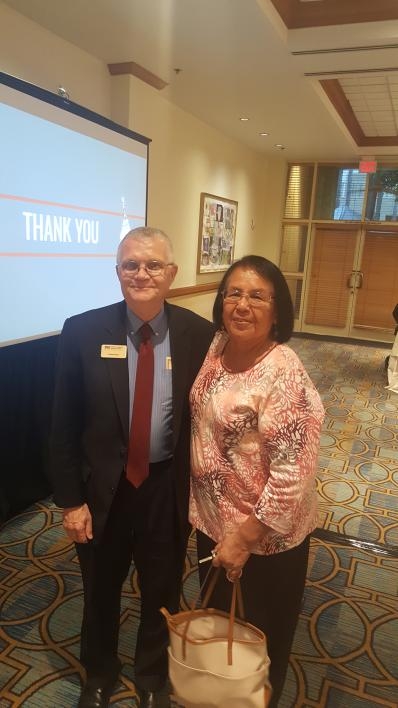ASU course helps grow community of Native changemakers
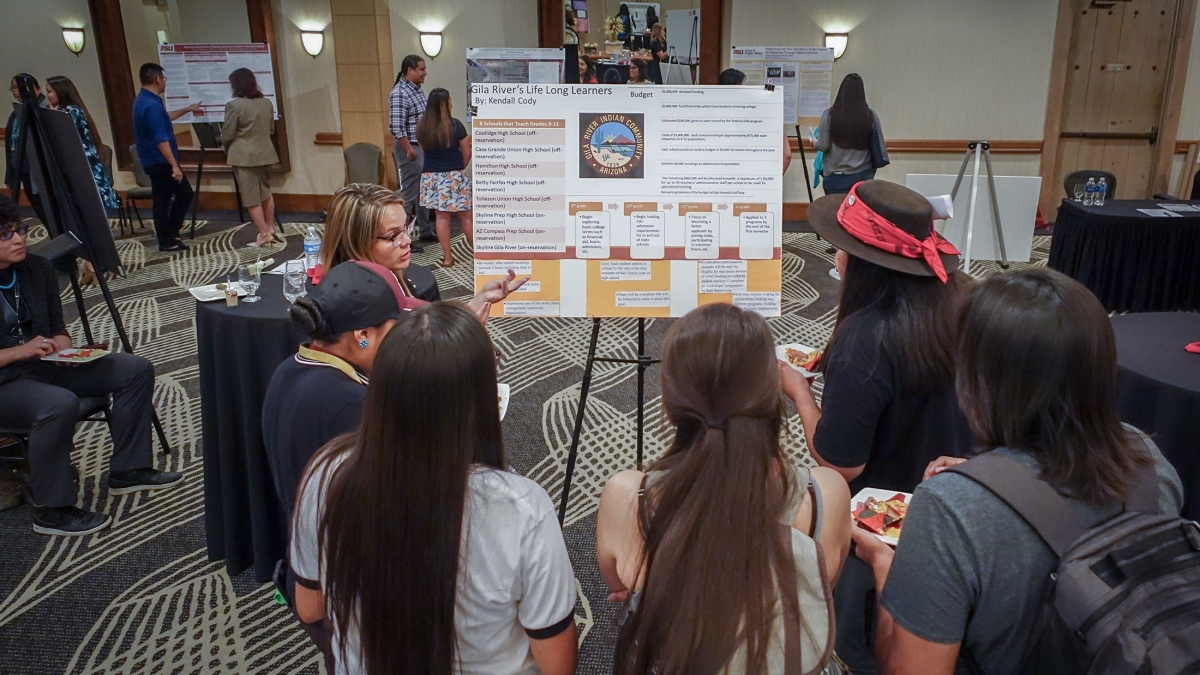
ASU graduating senior Kendall Cody discusses her proposal for a pre-college program for high schoolers, "“Gila River’s Life Long Learners." Cody and classmates in AIS 440: Cultural Professionalism showcased their work in ASU’s seventh annual Creating Visions for Future Nations Research Symposium, presenting their proposals in a poster-session format at the close of ASU’s annual American Indian Student Success Forum on March 21, 2017. Photo by Lyonel Tso
Editor's note: The ASU community, mindful of Arizona’s place in Indian Country and the university’s location on the ancestral homelands of the Akimel O'odham and Pee Posh peoples, aspires to support Native students and tribes in developing futures of their own making. Last week’s story “ASU American Indian Studies Program trains advocates for indigenous communities” discussed AIS’s focus on partnerships to strengthen communities. This story spotlights the ways that one course, AIS 440: Cultural Professionalism, contributes to that effort.
When Arizona State University graduating senior Kendall Cody walked across the stage at the university’s American Indian Convocation on May 10, she carried with her an admittedly big passion: “getting more people to pursue and complete higher education.”
She also left ASU with solid experience and confidence in directing that passion to make an impact.
Cody worked as a peer coach for the past two years with ASU’s First-Year Success Center, encouraging other students to make it to the graduation finish line and to discover ways to make the most of their college journey: “I absolutely loved my job, so it never felt like work,” said Cody, who graduated May 8 with a major in psychological science and a minor in American Indian studies.
In the spring semester, as part of the course American Indian Studies 440: Cultural Professionalism, Cody chose a project to encourage and support kids’ readiness to apply and be admitted to post-secondary education, laying out the design for a four-year college-application program to support high schoolers in the Gila River Indian Community, south of Phoenix.
In AIS 440, students draw on the ASU Libraries’ Labriola National American Indian Data Center and other sources to research the demographics and contemporary issues of Arizona’s 22 sovereign tribes. They then design a community development proposal directly connected to meeting one challenge in one Native nation or tribe beyond their home communities.
“An important U.S. Census statistic for Gila River that stood out in doing my background research was that 1.6 percent of adults indicated bachelor’s degree attainment,” said Cody, who is an enrolled member of the Navajo Nation.
She designed an extra-curricular program that would break down the higher-education application process into identifiable steps, mapping out goals and activities for youth from freshman through senior year.
“By first semester of their senior year, students would be ready to apply to at least three different colleges or universities,” Cody explained. “I suggested activities to support students’ not only having a strong application, but becoming a more holistic person by that time as well.”
When she and her AIS 440 classmates showcased their proposals in a poster session in March, Cody’s project, “Gila River’s Life Long Learners,” received this year’s undergraduate “community vote” for the project that symposium guests consider most innovative and practical.
That honor includes an award from the Princeton Review valued at $2,799, for an in-person test-prep course that Cody intends to use in advance of graduate school admissions exams.
Perhaps most noteworthy, at semester’s end Cody was contacted by a member of the Gila River Indian Community to schedule a meeting to discuss the possibility of implementing her project idea.
Undergraduate and graduate student participants in the AIS 440 poster symposium posed with Laura Gonzales-Macias and Miss Indian ASU 2015-2016 Jennifer R. Jones. From left: Nicholet Deschene Parkhurst, Jameson D. Lopez, Ferrin Brown Wolf, Matthew Yatsayte, Kyle Howe, Davis E. Henderson, Summer Kirk, Martisha Clyde, Kendall Cody, Marcene Hoover-Bennett, Kelly Lee, Laura Gonzales-Macis, Jennifer R. Jones, Latifah Pailzote, Sarahna Cooper, and Kayla DeVault.
Creating visions for future nations
“One of the key pieces of the American Indian Studies paradigm at ASU is strengthening communities, and at the core of this class is the use-inspired research assignment based in helping our families and communities,” said Laura Gonzales-Macias, who regularly teaches the course and also serves as associate director of American Indian Student Support Services in ASU’s University College.
The community development project proposal and the learning experiences that support it are the focus for about two months, she noted.
Students do a literature review, write a full research paper describing their review and project proposal, make an in-class slideshow presentation, and prepare and present at the annual poster symposium, “Creating Visions for Future Nations.”
The course, she said, was developed seven years ago with American Indian Studies Professors John Tippeconnic III and James Riding In. They designed an experience in which students can explore indigenous perspectives on communication, research and professional and leadership skills.
In addition, students can prepare for what comes next in their journey: building a track record in the kind of research and presentations required in graduate school; fine-tuning their resumes; setting and meeting goals for employment, internships or graduate applications; and beginning to build a professional network across tribal communities.
Over the years, she said, the course has continued to evolve in partnership with the students — and the overlap and connections that have grown between students and community mentors have been especially enriching.
Mentoring extends connections
Some mentors visit the class as presenters; others assist with project ideas, Gonzales-Macias explained.
“Once students decide on a community development project proposal, they’re matched with a research mentor — someone from the community or a graduate student or faculty member with expertise related to the project,” she said.
“We partner with ASU’s American Indian Graduate Student Association to match students with a graduate or professional student,” she continued, “and we are so fortunate to have a host of community mentors who generously engage with students in the course.”
Kendall Cody, for example, was matched with ASU graduate student Dorothy Rhodes, executive intern for the lieutenant governor of the Gila River Indian Community, who could share knowledge and suggest resources. (Rhodes graduated May 8 with a master’s degree in liberal studies.)
Cody said that Ak-Chin Indian Community Councilwoman Delia Carlyle’s guest presentation in AIS 440 also influenced how she shaped her project proposal.
“In addition to talking about Ak-Chin’s approach to self-governance and some of its exciting business partnerships, Ms. Carlyle shared her story with us. She wasn’t the best student in high school and other barriers popped up along her life journey, and so it was only recently that she earned her associate’s degree,” she said. “Despite all of those things that happened, she still has a very powerful leadership positon and is helping others in her community.
“A lot of students start fixating on whether they might mess up, or they think that if they haven’t finished a degree in four years they’ve failed,” Cody said. “Her remarks were a reminder to make sure that my programming for high school students would dispel those myths that stress a lot of people out and emphasize that working toward some post-secondary training to support what they want to do in life is the main goal.”
Other community leaders who presented to students this semester were LuAnn Leonard, former Arizona Board of Regent and executive director of the Hopi Education Endowment Fund, Hopi Tribe; Arizona House Democrats Indigenous Peoples Caucus members Rep. Sally Ann Gonzales, D-Tucson (District 3) and Rep. Eric Descheenie, D-Chinle (District 7); and Robin Enos, human resources director, and Crystal Banuelos, community employment manager, with the Salt River Pima–Maricopa Indian Community.
Banuelos, a 2003 ASU graduate, said she has enjoyed being a community presenter in AIS 440 for five years, sharing insights about preparedness for the job search and professionalism.
“I try to give students guidance and confidence about how they can be the best potential candidate, in whatever area that interests them, and encourage them to grow those behaviors that will make them the best employee after being hired,” Banuelos said, “focusing on being a team player, being willing to go above and beyond, and being communicative.”
“I also talk with students about where the workforce is going or areas that might have longevity,” she said. “That may spark ideas for some individuals as they make the determination of the path that’s best for them.”
This spring semester, built into the AIS 440 course, was an opportunity for the students to be mentors themselves and build additional connections.
“We have a business etiquette dinner as part of the course, and this semester Tohono O’odham Community College (TOCC) staff and high school students in the START program, a TOCC pre-college outreach program, came up from Sells to join us for the dinner session at Tempe Mission Palms hotel,” said Gonzales-Macias. “Students in my class as well as other ASU Native students enjoyed meeting and giving advice to Tohono O’odham youth.”
Laying the foundation for a professional career
Three years ago ASU alumna Waynette Taylor took AIS 440 with Gonzales-Macias as a senior and completed a proposal for a community development project titled “Live Well, Be Well: A Holistic Approach to Treating Diabetic and Obese Individuals in the Salt River Pima–Maricopa Indian Community.”
She proposed a holistic, culturally sensitive approach to educating newly diagnosed diabetic and obese patients and put her central emphasis on an effective treatment plan developed by a comprehensive health-care team.
Taylor sees the course and that project proposal as laying a foundation for her career.
“I knew Laura’s class was going to be great, but I didn’t realize the full impact it would have on my life,” she said.
“I decided eight years ago that I wanted to become a physician assistant, the first in my extended family to ever pursue a medical career, but I didn’t have any idea about how I’d become a medical provider.”
At ASU she fell in love with her major — biological sciences — and she became a leader in the student organization PANAL (Pre-Health Association of Native American Leaders).
“In completing the community development proposal in AIS 440, I discovered how I could make an impact in a community. The project only intensified the amount of passion I had for diabetes-related work,” said Taylor, whose mother and several other family members cope with the disease.
She credits AIS 440, and all the commitment that she put into the class, for her securing an internship with the National Institutes of Health (NIH) the summer after she graduated, and for her ability to perform at a competitive level in the position.
“I was more confident in my research and was more familiar with how to summarize my work to NIH scientists,” said Taylor, who asked as an intern that she be allowed to focus on diabetes.
“My individual project focused on identifying the genetic determinants of Type 2 diabetes among the Pima Indians,” she said. “In the genetic laboratory of the NIDDK, a branch of the NIH, I helped to identify variants predicted to be deleterious in biological candidate genes, validated those sequences, genotyped, then submitted them for analysis to determine if these variants could affect risk for T2D. I would not have been as confident as I was in the delivery of my research if it were not for the experience I had gained in AIS 440.”
Since earning her degree in 2014 she became a patient-care assistant at Banner Desert Medical Center and cared for diabetic patients, to learn more about the real-life complications and co-morbidities associated with the disease. Taylor now works for Indian Health Services in a behavioral health facility as a counselor aide to at-risk adolescents, helping them to rebuild their lives.
“I still keep in touch with some of the community leaders who served as mentors and guest speakers in the course,” she said, “and when I read or hear the names of others in the news or in my work I’ll have that feeling of connection.”
Taylor said the AIS 440 poster symposium has become an event around which alumni of the course and current students, faculty and staff coalesce.
“I attended the AIS 440 poster symposium last year and was very impressed with the students’ work. Now as an alum I’m totally supportive of the students and want to be a part of the symposiums in the future, letting students know it’s possible for them to implement their work in Native communities.”
She has accepted a place in Northern Arizona University’s physician assistant professional graduate program for fall. Taylor said she used the Princeton Review scholarship she earned as the “community vote” winner in the 2014 AIS 440 poster session to help prepare for the GRE.
“Dr. Gonzales-Macias is a remarkable individual. I have a lot of appreciation for her because of how much of an impact she has made on my life,” Taylor said of her mentor and former teacher. “My career aspirations are to return home to the Navajo and Hopi reservations as a physician assistant to care for individuals who are affected by diabetes. I believe that a program like the one I proposed in AIS 440 could make a real difference in any community, and it is my personal goal to see it come to life.”
Inspiring new passions
When the spring 2017 AIS 440 students made their final class presentation as a group, gathering with community leaders for an end-of-semester celebration and formal dinner at Tempe Mission Palms on May 2, undergraduate Ferrin Brown Wolf reflected on the transformation he felt in himself over the semester.
“Are you a person who looks down the road, or do you look at the here and now? I’m transforming to where I’m looking down the road,” he said, as students took stock of all they’d learned from the readings, assignments and community mentors.
Brown Wolf said that closely following the protests at Standing Rock this year, where his grandmother’s people are, had energized him.
“Eric Descheenie, when he visited our class, said to us: ‘Your passion finds you.’ It has me thinking I need to get into law school. I’m going for an IT degree, but will I be happy if I’m punching in code, not doing things for my people?”


